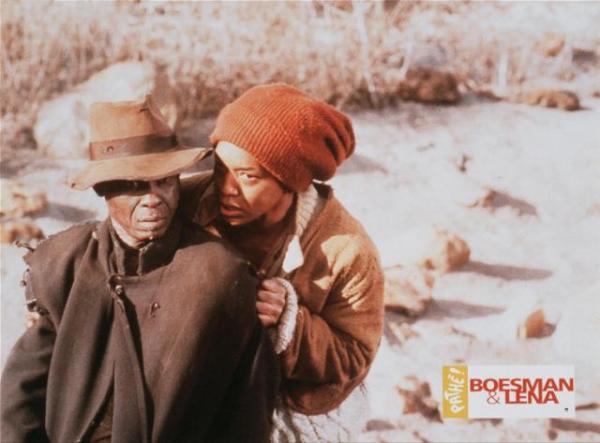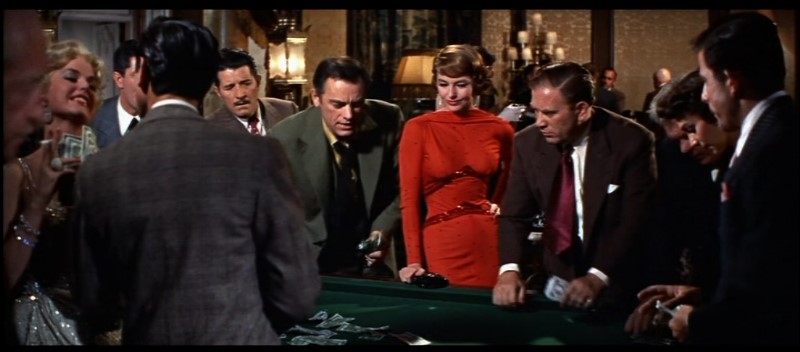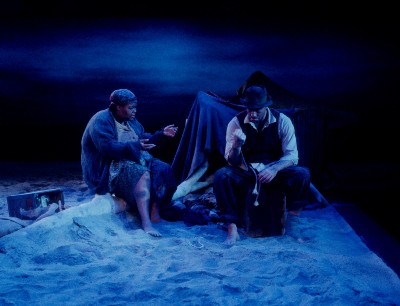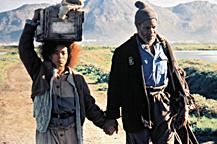It’s really sad: Wikipedia had listings for no less than eight different men named John Berry when I originally posted this article, but the film director (1917-1999) wasn’t one of them (fortunately, this is no longer the case); and you won’t find an article about him in Senses of Cinema’s Great Directors, either. I can’t say I knew the man well. but I consider myself fortunate to have spent some time with him in a variety of places — including film festivals in Rotterdam and Vienna, in Paris, and even one enjoyable evening at a jazz disco in Taipei. His accounts of his experiences with Orson Welles in the Mercury Theater -– which included several hours of holding up scenery during the shooting of Too Much Johnson — were priceless.
The following comes from the February 2, 2001 issue of the Chicago Reader. — J.R.
Directed by John Berry.
Written by Athol Fugard and Berry.
With Danny Glover, Angela Bassett, and Willie Jonah.
Director John Berry got his big start as an actor in Orson Welles’s Mercury Theatre in 1937. Welles then introduced him to film in 1938 when he hired him as assistant director on a silent slapstick film made to accompany and introduce portions of the stage farce Too Much Johnson. (The farce never made it to Broadway, alas, and the film was [allegedly] lost in a 1970 fire in Welles’s villa in Madrid [but was found virtually intact last year].) In 1941, shortly before the release of Citizen Kane, Berry acted in and was stage manager on Welles’s adaptation of Richard Wright’s Native Son when it reopened in New York and then went on a national tour, where he redesigned the production for each location. Berry directed six features in Hollywood over a five-year period (1946-’51) before fellow director Edward Dmytryk identified him as a communist. Blacklisted, Berry moved to Paris, where he basically had to start his life over. He moved around a lot to find jobs, even back to Hollywood in the 70s to make movies as diverse as Claudine (a wonderful romantic comedy matching James Earl Jones as a garbage man with Diahann Carroll as a ghetto mother) and The Bad News Bears Go to Japan (which I haven’t seen, but nobody seems to like). But Paris remained his base of operations until his death at 82 in December 1999; he even found occasion to work there for Welles, dubbing some of the voices in The Trial in the early 60s. (The only French film of his that I know — the 1957 Tamango, which turned up at Navy Pier three summers ago — pairs Dorothy Dandridge and Curt Jurgens on a slave ship, which was more than American distributors could contemplate at the time; it isn’t one of Berry’s best, though it’s still a lot more interesting than Amistad.) One little-known fact about Berry is that he was the father-in-law of Jean Seberg and Anna Karina (they each married his son Dennis, who had a role in Jacques Rivette’s L’amour fou); the last time I saw Berry was when he was traveling with Karina. I spent time with Berry in the 90s, mostly at film festivals. He was a gruff, robust bear of a man who clearly hailed from the Bronx, was never pretentious, and always looked at least 10 or 15 years younger than he was. He also took more pleasure in talking about Welles than anyone I’d ever met. Pierre Rissient, one of his best friends and biggest champions (and one of the producers of Boesman & Lena, his last film, playing several times this week at the Film Center), says Berry always placed life above cinema, a preference that defined what’s valuable about his cinema. I’m not sure I’d call Berry a great director, but he was sometimes an exceptionally good one, especially when he dealt with working-class characters (as in From This Day Forward, He Ran All the Way, and Claudine) and sometimes when he worked with black actors, whom he enjoyed directing. He was able to do both in his last feature, his own adaptation of a play by Athol Fugard set in apartheid South Africa that he successfully directed on the New York stage in 1970, the year after it premiered in South Africa. I never saw any of Berry’s theater work, which was extensive and included productions of another Fugard play, Blood Knot, in London and New York. (The well-received New York productions of both Blood Knot and Boesman and Lena starred James Earl Jones, and thus helped him become better known.) The New York Times obituary says Berry made more than 50 films, but this seems pretty unlikely — the first edition of Ephraim Katz’s Film Encyclopedia lists only 18 titles through 1978. I’ve seen only eight or nine of his works, and one striking way that Boesman & Lena — a French-South African production filmed exclusively in Cape Town — differs from the others is in its unabashed theatricality, which gives it an experimental flavor. 
This theatricality is one reason Boesman & Lena can’t be regarded as an unqualified success, but formally it’s the most adventurous Berry film I know — and it’s remarkable that he made it at 82. He died as he was finishing it.
This is the second film of this play; the first was a 1974 South African film directed by Ross Devenish, with Fugard himself playing the part of Boesman. The minimal story focuses on the quarrelsome couple of the title (Danny Glover and Angela Bassett), whose home in a shantytown is flattened by bulldozers in black-and-white footage shown during the credits. Having been evicted in this fashion many times before, they travel down a dirt road near the Swartkops River before spending a night on the flats. They live mainly by selling recycled bottles, and they make a grim pair, despite brief and wordless flashbacks (which Berry called “memory flashes”) that show them periodically enjoying a much happier life. Boesman is by far the less sympathetic of the two, a rare departure for Glover, who usually banks on his charisma; he’s physically and verbally abusive, petty, paranoid, and selfish. Lena is so troubled and disconsolate that she can barely remember at times who she is. The only other figure who appears — a Xhosa tribesman (Willie Jonah) who speaks a language they can’t understand and is befriended by Lena before he dies during the night — is closer in some ways to a prop or stage device than a character. Several reviewers have compared the play to Waiting for Godot, but I think they’ve missed the social observations Fugard, Berry, and the actors are concerned with: the physical absence of whites only helps demonstrate how much their racism and intolerance have affected the behavior of the two leads. A better point of comparison might be a play by John Cassavetes that’s unfortunately not well-known, A Woman of Mystery, his last realized work. It ran for only two weeks in Beverly Hills during the summer of 1987, with Gena Rowlands as a bag lady and Carol Kane as another derelict who claims to be her daughter. Like Boesman & Lena, it concerns the loss of identity that stems from homelessness and the way rejection by others becomes internalized, leading to mental abuse of oneself and others. These are dark subjects, though Berry’s adaptation reportedly makes the ending more hopeful than it was in the original. And the actor-based direction, as in the case of the Cassavetes play, makes this a potent collective investigation into what makes people tick, honored by Glover’s and Bassett’s resourcefulness at every turn. The film also engineers a sharp confrontation between theater and film, with natural locations made to seem stagy and the sudden “memory flashes” that cut into the action given the curt aggressiveness of dropped curtains. At the same time, the purely theatrical declamatory styles of Basset and Glover, both acting up a storm in what sometimes feels like a void, are framed by a camera that moves, making the settings more volatile. Meanwhile, the blocking of space and the parsing of lines become juggling acts of foreground and background, speech and song that exploit the visual dynamics of CinemaScope and evoke the tensions of Nicholas Ray, who was only six years older than Berry. I haven’t yet been able to see Boesman & Lena on anything but a letterboxed video in stereo, but it’s a big-screen experience through and through, in much the same way that Ray’s 50s ‘Scope films are, with sound as relevant to the experience as image (think, for instance, of Rebel Without a Cause, Bigger Than Life, Bitter Victory, and Party Girl). 
If you’re looking simply for a driving narrative, you aren’t likely to feel satisfied by Boesman & Lena. It premiered in this country last fall at the New York film festival, and when it opened in theaters soon afterward, it was sourly received in some quarters, judging by reviews such as Michael Atkinson’s in the Village Voice. “Long a race-relations flag-waver” was his ungenerous way of describing Berry — a man I can’t imagine waving any flag under any circumstance — and his verdict on the film, which he called “no challenge to middlebrow sanctimony,” was “I haven’t suffered such overcooked caterwauling since my first Rangers game.” 
But I found this showcase for Glover and Bassett, not to mention Berry’s mise en scene, sensitive, often affecting, and mesmerizing. It was plainly a labor of love for the actors as well as the director, and if you’re initially put off a little by the two actors’ efforts to persuade us that they’re South African, this is ultimately less of a cheat than, say, the efforts of the cast of Julian Schnabel’s Before Night Falls to persuade us that they’re speaking Spanish by throwing in occasional Spanish phrases whenever they get excited. Eventually the power of the performances, characters, and direction takes over, and one gets a profound, nuanced feeling for what it means to be poor and disenfranchised, something that formed the hub of Berry’s best work in Hollywood — in From This Day Forward, He Ran All the Way, Tension, Claudine, and perhaps in other films as well. All things considered, it was a nice way for Berry to wind up his career.



